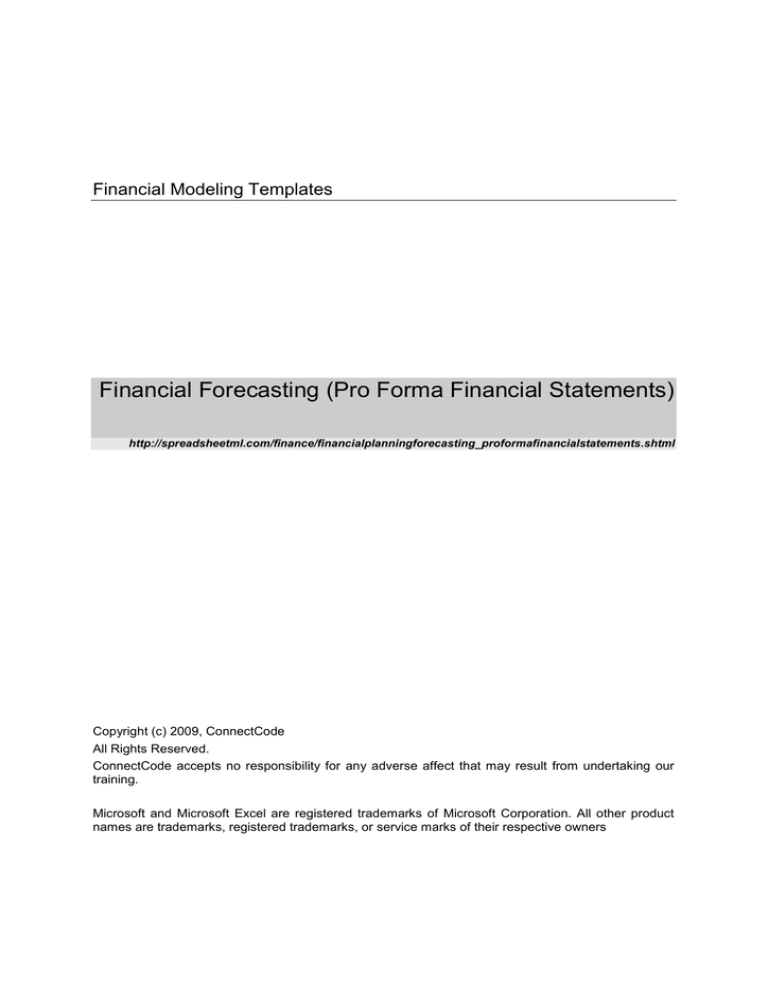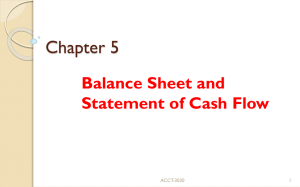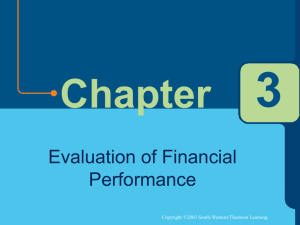
Financial Modeling Templates
Financial Forecasting (Pro Forma Financial Statements)
http://spreadsheetml.com/finance/financialplanningforecasting_proformafinancialstatements.shtml
Copyright (c) 2009, ConnectCode
All Rights Reserved.
ConnectCode accepts no responsibility for any adverse affect that may result from undertaking our
training.
Microsoft and Microsoft Excel are registered trademarks of Microsoft Corporation. All other product
names are trademarks, registered trademarks, or service marks of their respective owners
Table of Contents
1.
2.
Financial Planning and Forecasting ................................................................................... 1-1
1.1
Pro Forma Financial Statements ............................................................................... 1-1
1.2
Financial Statements Modeling .................................................................................. 1-1
Financial Planning and Forecasting Spreadsheet ............................................................. 2-2
2.1
Financial Statements Inputs ....................................................................................... 2-2
2.1.1 Income Statement ......................................................................................... 2-2
2.1.2 Balance Sheet ............................................................................................... 2-3
2.2
Common Size Financial Statements .......................................................................... 2-4
2.2.1 Fields from the Income Statement ................................................................ 2-4
2.2.2 Fields from the Balance Sheet ...................................................................... 2-4
2.2.3 Average ......................................................................................................... 2-5
2.3
Analysis Findings ....................................................................................................... 2-5
2.4
Financial Statements Forecast .................................................................................. 2-5
2.4.1 Assumptions.................................................................................................. 2-5
2.5
Financial Ratio Analysis ............................................................................................. 2-5
2.5.1 Inputs ............................................................................................................ 2-6
2.5.2 Liquidity Ratios .............................................................................................. 2-6
2.5.3 Leverage Ratios ............................................................................................ 2-6
2.5.4 Profitability Ratios ......................................................................................... 2-6
2.5.5 Turnover Ratios............................................................................................. 2-6
Pg ii
Financial Planning and Forecasting
Version 1.0
ConnectCode’s Financial Modeling Templates
Have you thought about how many times you use or reuse your financial models? Everyday, day
after day, model after model and project after project. We definitely have. That is why we build all
our financial templates to be reusable, customizable and easy to understand. We also test our
templates with different scenarios vigorously, so that you know you can be assured of their
accuracy and quality and that you can save significant amount of time by reusing them. We have
also provided comprehensive documentation on the templates so that you do not need to guess or
figure out how we implemented the models.
All our template models are only in black and white color. We believe this is how a professional
financial template should look like and also that this is the easiest way for you to understand and
use the templates. All the input fields are marked with the ‘*’ symbol for you to identify them
easily.
Whether you are a financial analyst, investment banker or accounting personnel. Or whether you
are a student aspiring to join the finance world or an entrepreneur needing to understand finance,
we hope that you will find this package useful as we have spent our best effort and a lot of time in
developing them.
ConnectCode
Pg iii
Financial Planning and Forecasting
Version 1.0
1.
1.1
Financial Planning and Forecasting
Pro Forma Financial Statements
Financial statements projections and forecasting are very common in corporate financial analysis.
The reason is that it is very useful and important to forecast how much financing a company will
require in future years. The projections are achieved by using historical sales, accounting data and
assumptions on future sales and costs. These financial statements projections are known financial
modeling as Pro Forma financial statements.
1.2
Financial Statements Modeling
This spreadsheet provides a template for financial statements forecasting. It requires simple
financial statements inputs from the past 5 years and will automatically generate all the necessary
Pro Forma Financial Statements projections outputs.
The following diagram illustrates the process of using this template for financial statements
forecasting. Most inputs are required in the first step. The rest of the four steps involve reviewing
the outputs generated and entering values like short term interest rates to be assumed in the
model.
Pg 1-1
Financial Planning and Forecasting
Version 1.0
2.
2.1
Financial Planning and Forecasting Spreadsheet
Financial Statements Inputs
The template requires inputs from the Income Statement and Balance Sheet from the past 5
years.
2.1.1
Income Statement
All inputs are marked with the "*" symbol.
The fields that are automatically calculated as shown in bold below.
Revenues
Sales*
Cost and expenses:
Cost of sales*
Selling, general and administrative expense (SG&A)*
Research and Development*
Depreciation*
Operating income = Sales - Cost and expenses
Interest
Interest expense*
Interest income*
Net Interest = Interest income - Interest expense
Income before taxes = Operating income + Net Interest
Income taxes*
Net income = Income before taxes - Income taxes
Common Shares*
Earnings per Share = Net income / Common Shares
Dividends paid*
Retained Earnings = Net income - Dividends paid
Pg 2-2
Financial Planning and Forecasting
Version 1.0
2.1.2
Balance Sheet
All inputs are marked with the "*" symbol.
The fields that are automatically calculated as shown in bold below.
Assets
Cash and cash equivalents*
Accounts receivable*
Inventories*
Deferred income taxes*
Total current assets = Cash and cash equivalents + Accounts receivable +
Inventories + Defered income taxes
Fixed assets
Cost*
Accumulated Depreciation*
Net fixed assets = Fixed Assets Cost - Accumulated Depreciation
Goodwill*
Intangible assets*
Other assets*
Total assets = Total current assets + Net fixed assets + Goodwill + Intangible
assets + Other assets
Liabilities
Accounts payable*
Current debt = Total liabilities – Accounts payable – Long-term debt - Other longterm liabilities
Total current liabilities = Accounts payable + Current debt
Long-term debt*
Other long-term liabilities*
Total liabilities = Total liabilities and shareholder's Equity - Total Shareholders'
Equity
Shareholders' equity
Common Stock and Additional Paid in Capital*
Retained Earnings*
Total Shareholders' Equity = Common Stock and Additional Paid in Capital +
Pg 2-3
Financial Planning and Forecasting
Version 1.0
Retained
Earnings
Total liabilities and shareholders' Equity = Total assets
The Total liabilities and shareholders' Equity field is worth noting. It is set to be equal to the Total
assets in the spreadsheet.
Total liabilities and shareholders' Equity = Total assets
Total liabilities field is calculated as follows:
Total liabilities = Total liabilities and shareholder's Equity - Total Shareholders' Equity
The Current debt field is the Plug. It is defined as follows:
Current debt = Total liabilities – Accounts payable – Long-term debt - Other long-term
liabilities
2.2
Common Size Financial Statements
The Common Size Financial Statements express all the fields in the Income Statement and Balance
Sheet as a ratio over Sales. By expressing the fields in ratio, a standardized financial statement
can be created to reveal insights and trends of companies. It will be easy to compare financial
statements of different size companies or the same company at different times. For example, a
company may have grown to be very large over the years.
2.2.1
2.2.2
Fields from the Income Statement
Cost of Sales in 1999 = Cost of Sales in 1999 / Sales in 1999
Cost of Sales in 2000 = Cost of Sales in 2000 / Sales in 2000
Depreciation in 1999 = Depreciation in 1999 / Sales in 1999
Interest expense in 2003 = Interest expense in 2003 / Sales in 2003
Fields from the Balance Sheet
Cash and cash equivalents in 2001 = Cash and cash equivalents in 2001 / Sales in 2001
Accounts receivable in 2002 = Accounts receivable in 2002 / Sales in 2002
Pg 2-4
Financial Planning and Forecasting
Version 1.0
2.2.3
Average
An average of the past 5 years percentage is also calculated. This average will be useful for
projections and forecasting of future financial positions.
2.3
Analysis Findings
2.4
Sales Growth Rate = (Sales in Current Year - Sales in Previous Year) / Sales in Previous
Year
Tax Rate = Income taxes / Income before taxes
Dividends payout ratio = Dividends paid / Net income
Financial Statements Forecast
The main inputs in the Financial Statements Forecast worksheet are the Short term and Long term
debt interest rate. By default, The Sales Growth Rate, Tax Rate and Dividends payout ratio make
use of the average value for the past 5 years. Adjustments can be further made to these figures
for better accuracy in forecasting.
2.4.1
2.5
Assumptions
Sales Growth Rate = Average Sales Growth Rate in Analysis Findings Worksheet
Tax Rate = Average Tax Rate in Analysis Findings Worksheet
Short term debt interest rate*
Long term debt interest rate*
Dividends payout ratio = Average Dividends payout ratio in Analysis Findings Worksheet
Financial Ratio Analysis
This worksheet outputs the different financial ratios calculated from the Income Statement and
Balance Sheet from the other worksheets.
Pg 2-5
Financial Planning and Forecasting
Version 1.0
2.5.1
Inputs
The Share Price for the different years is the only input in this worksheet. Using the Share Price
and information from other worksheet like assets, liabilities, cash and costs, the different ratios are
calculated.
2.5.2
Liquidity Ratios
The liquidity ratios provide information about a company's ability to repay its short-term debt.
2.5.3
Current Ratio = (Current Assets/Current Liabilities)
Acid Test Ratio = ((Current Assets-Inventories)/Current Liabilities)
Current Cash Debt Coverage Ratio = (Operating Cash/Average Current Liabilities)
Leverage Ratios
The leverage ratios provide information about a company's long term solvency. The leverage ratios
focus on the long term as compared to liquidity ratios which focus on the short term.
2.5.4
Debt to Total Assets = (Total Debt/Total Assets)
Times Interest Earned = (EBIT/Interest)
Cash Debt Ratio = (Operating Cash/Average Total Liabilities)
Profitability Ratios
The profitability ratios provide information about the success of the company at making profits.
2.5.5
Gross Profit Margin = ((Sales-COGS)/Sales)
Earnings per Share = (Net Income/Number of Shares Outstanding)
Profit Margin on Sales = (Net Income/Net Sales)
Return on Assets = (Net Income/Average Total Assets)
Return on Equity = (Net Income/Average Equity)
Price Earnings Ratio = (Share Price/EPS)
Dividends Payout Ratio = (Dividends/Net Income)
Turnover Ratios
Receivables turnover provides information on how quickly a company collect its accounts
receivables. Inventory turnover provides information about the number-of-days worth of inventory
on hand. A low turnover may point to a situation where overstocking has occurred. Asset turnover
ratios provide information on how efficiently a company utilizes its assets.
Receivables Turnover = (Net Sales/Average Receivables)
Inventory Turnover = (COGS/Average Inventory)
Asset Turnover = (Net Sales/Average Total Assets)
Days' sales in inventory = (365/Inventory Turnover)
Days' sales in receivables = (365/Receivable Turnover)
Pg 2-6
Financial Planning and Forecasting
Version 1.0




